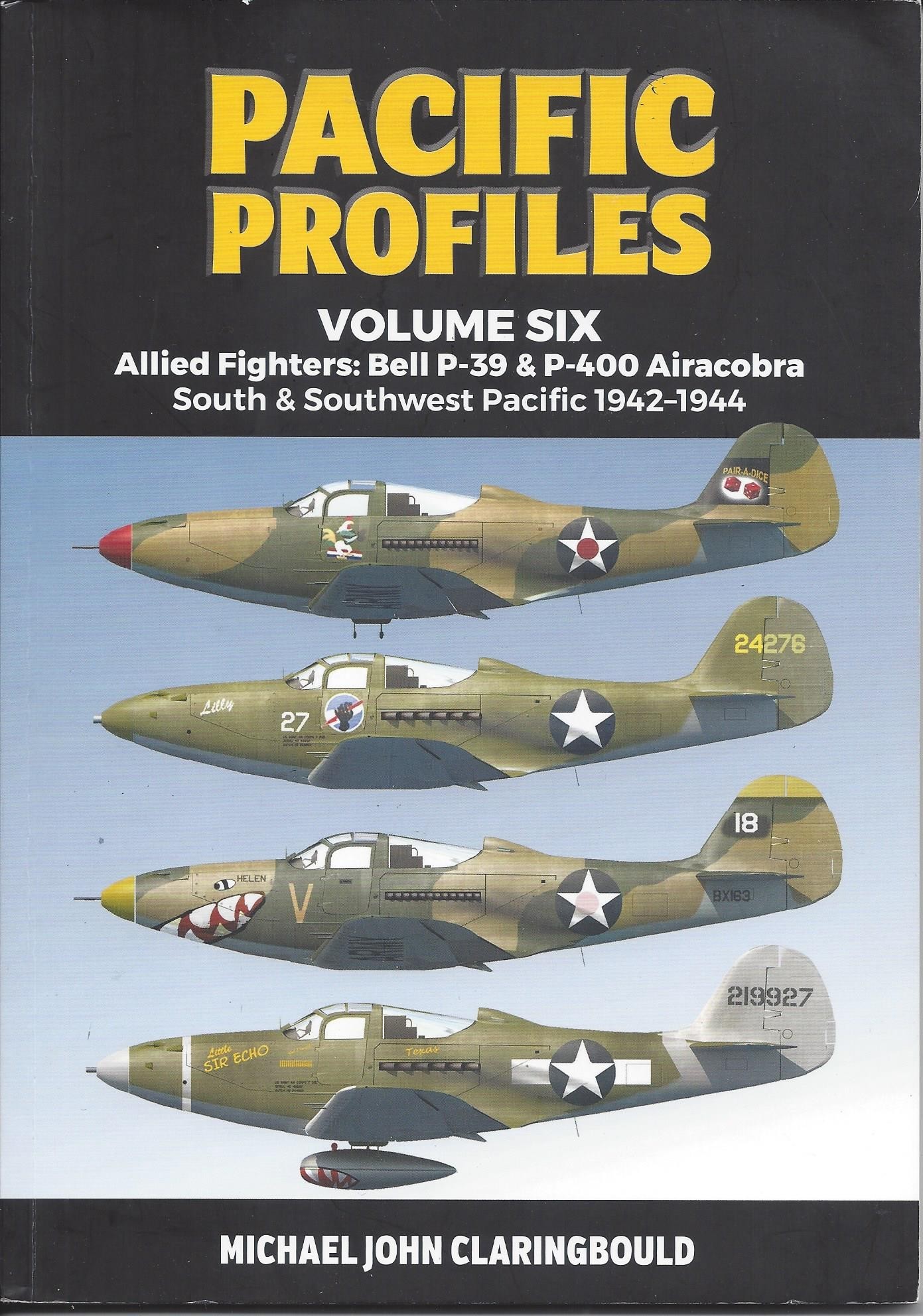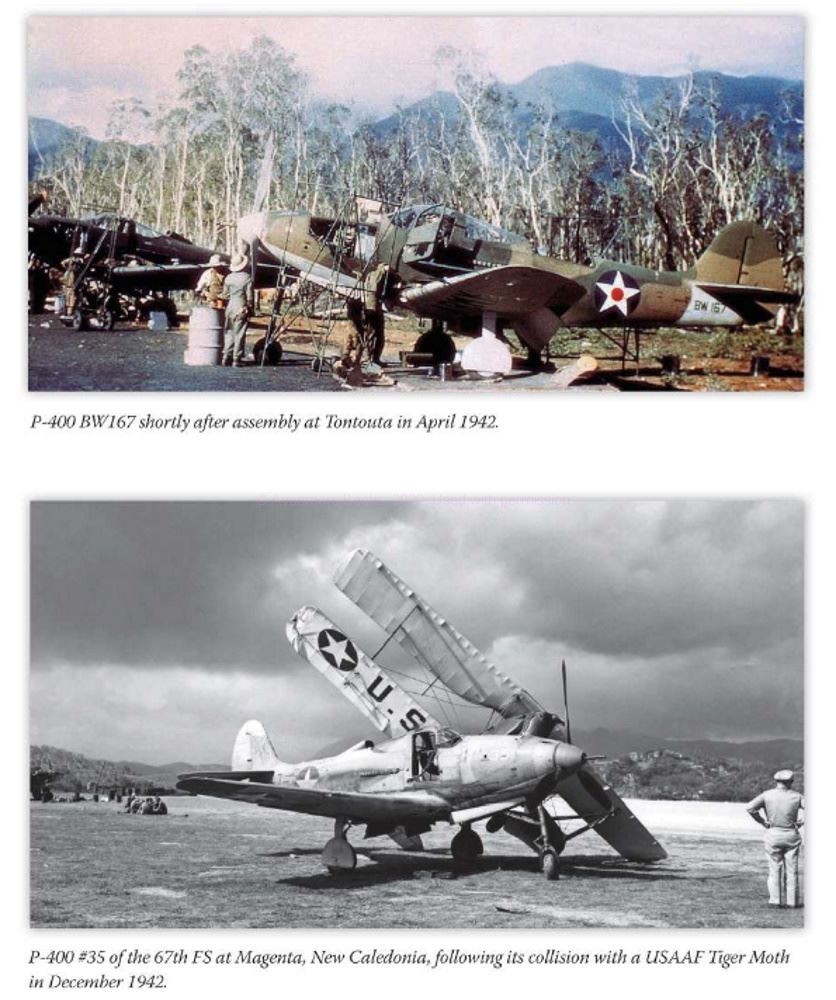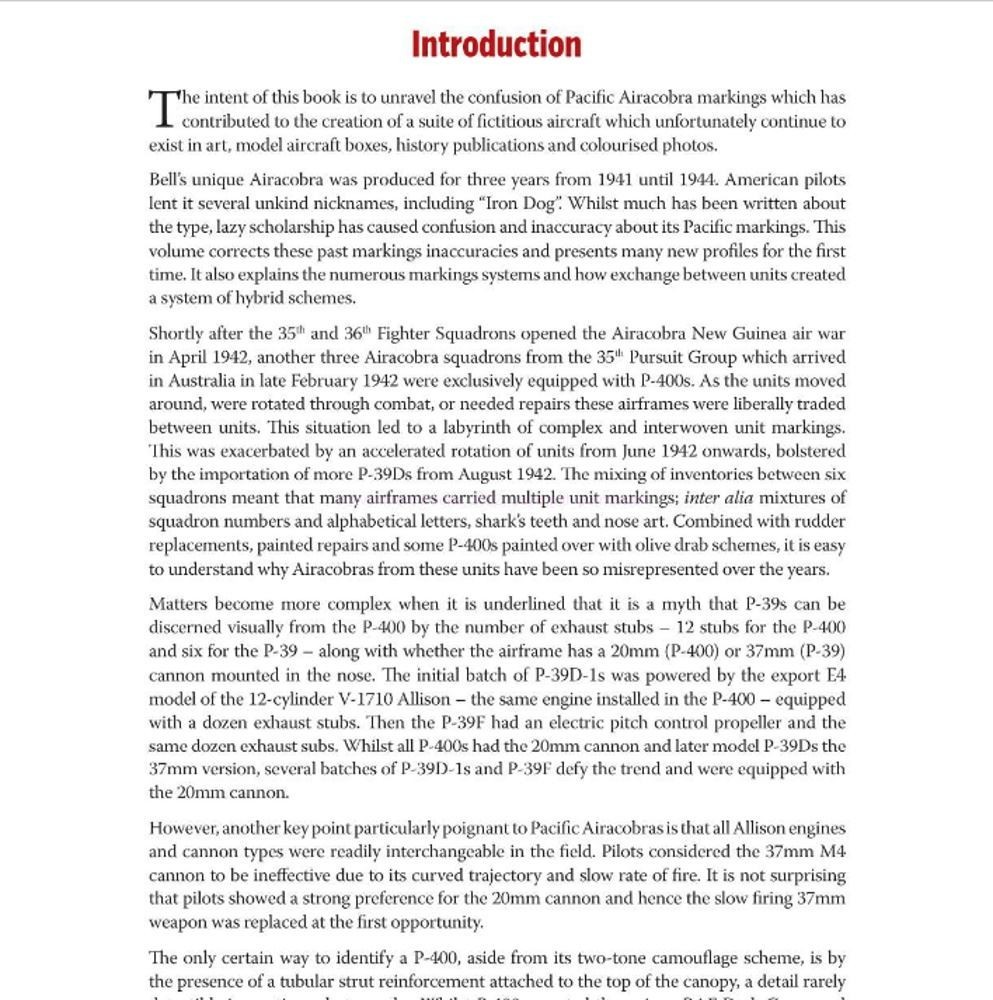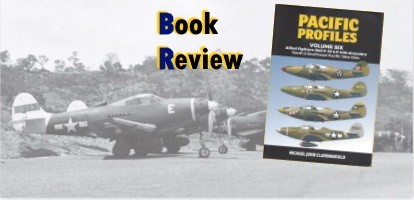
Introduction
P-39 Airacobras fought all around the world in the Second World War, except in the China-Burma-India Theater. Bell Aircraft Corporation created some innovative and historically significant aircraft, some being highly controversial. The P-39 family is of the latter. The fascinating revolutionary design was the mount of the highest scoring pilot flying an Allied fighter design (it even beats the the Brewster Buffalos flown by Finnish ace Ilmari Juutilainen). It also wore some of the more notorious colors and markings of its day, and is a favorite of modelers of less-loved types.
Legends and myths have been perpetuated for decades, and this new book corrects the record and includes new markings and information. The Fortunately, survivors of the era have emerged with a growing amount of surviving original documents and relics. An increasing cadre of modelers and researchers privy to such resources, dedicated to analyzing actual colors and markings, are establishing a more homogeneous consensus of the subject.
Pacific Profiles Volume Six Allied Fighters: Bell P-39 & P-400 Airacobra South & Southwest Pacific 1942-1944 is a recent title from Avonmore Books, which specializes in high-quality printing of titles focusing on the early part of the air war in the southwest Pacific. It is authored and illustrated by world-renowned wartime Japanese aviation expert and former diplomat Michael John Claringbould, who was raised in Port Moresby. These subjects are a life-long pursuit of his. Composed of 120 pages including the index, it is published by Avonmore Books and catalogued with ISBN 9780645246902. Avonmore tells us:
Volume Six covers a dozen USAAF Fifth and Thirteenth Air Force squadrons which operated the Bell P-39 and P-400 Airacobra from April 1942 until March 1944. They were used in a variety of roles including as fighters, dive-bombers and strafers. The wide-ranging colourful heraldry and nose art of Fifth Air Force Airacobras is partly explained by the frequent trading of particular airframes between units. Until now there has been a paucity of information about the markings of Thirteenth Air Force Airacobras, and this volume fills much of this wide gap. The first and last Airacobras lost in the theatre are illustrated, along with rare markings of a night fighter and a P-39 used by Fifth Fighter Command.
This volume includes the early P-400s through to the P-39D/F/Ks and then the late model P-39N/Qs. The development of markings for each squadron is explained, together with brief squadron histories accompanied with supporting photos. A wide range of reference material was consulted including many rare photos, colour movies, official records, diaries and photos from wreck sites.
The author, Michael Claringbould, is world-renown for his expertise on the Pacific air war. Never before have such meticulous colour profiles been illustrated with a full explanation of their markings.
The seeds for author Claringbould’s passion were planted in 1976 when, "...an irritable priest at Alexishafen, on New Guinea's north coast, reluctantly allowed me to scour and photograph Japanese aircraft wrecks on the mission's land," where he found a Ki-43-II. "Curiosity caused me to start collecting all material on this arcane subject, but it was frustrating. Few publications, including Japanese-language ones, agreed on interpretations..." Thus he began decades of research to learn and clarify.
Mr. Claringbould has authored more than 20 other titles. Most concern the South Pacific air war. His series Pacific Profiles currently offers eight titles, focusing on Japanese Army fighters, Japanese Army bombers, transports and miscellaneous types, Allied medium bombers, Allied fighters, transports, and Japanese seaplanes. You can view the book on the company website here: Pacific Profiles Vol. 6: Bell P-39 & P-400.
Content
Pacific Profiles Volume Six Allied Fighters: Bell P-39 & P-400 Airacobra South & Southwest Pacific 1942-1944 is brought to us through 120 pages with 13 chapters and sections:
About the Author
Introduction
Glossary
Chapters:
1. Markings
2. 12th Fighter Squadron “Dirty Dozen”
3. 35th Fighter Squadron “Black Panthers”
4. 36th Fighter Squadron “Flying Fiends”
5. 39th Fighter Squadron “Cobras”
6. 40th Fighter Squadron “Fightin’ Red Devils”
7. 41st Fighter Squadron “Flying Buzzsaws”
8. 67th Fighter Squadron “Fighting Cocks”
9. 68th Fighter Squadron “Lightning Lancers”
10. 70th Fighter Squadron “White Knights”
11. 80th Fighter Squadron “Headhunters”
12. 82nd Reconnaissance Squadron (Fighter) “Strafin’ Saints”
13. 110th Reconnaissance Squadron (Fighter) “Musketeers”
14. Unique Airacobras
Sources & Acknowledgements
Index of Names
Introduction begins with a brief history of Airacobra research wherein the author explains the imprecise and confusing world of Airacobra markings, and the fact that gaps exist in the knowledge base. He remarks upon the generations of perpetuated misunderstood aspects of P-39 colors and markings, as well as the mistakes concerning visually identifying the P-39 from the export P-400 by exhaust stacks and nose gun. (Hint – there is one unique way that has nothing to do with interchangeable parts or colors and markings.) Camouflage and especially markings could drastically change after maintenance or transfer of airframes between squadrons, and even changes on the production line. He further explains that interchangeability of major components created Bell fighters that were neither P-39s nor P-400s. Almost two pages focus specifically on the P-400, discussing model number similarities and the RAF rejection of the fighter for European combat. Especially useful is the noting of British serial numbers. How the P-39/P-400 soldiered on after more capable fighters arrived is explained in three detailed yet concise paragraphs.
Historical depth includes interesting nuggets, i.e., the names of the first flight of P-39s and pilots to arrive in New Guinea, a backstory of the first P-39 ace, and amazing gems such as mention of 20mm underwing gun pods.
Markings consists of ten intriguing pages of detailed presentations of a wide range of markings:
- National Insignia
- British Roundel
- Pre-war to August 1942
- Early 1942 onwards
- May 1942 onwards
- July 1943 onwards (no technical specification)
- June through August 1943 (Specification AN-1-9A)
- August 1943 (Specification AN-1-96)
- Further explorations include P-39 Serial Numbers
- P-400 RAF Serials, Airframe and Batch Numbers
- USAAF Fuselage Serials
- Theater Markings
- Formation Markings
- Individual Markings and Art
- Squadron Insignia
- Emblems (commentary how some lasted into Vietnam and today)
Those subjects contain impressive detail such as USAAC (US Army Air Corps) Circulars by number and date when known, the confusion of Bell construction numbers in relation to batch numbers and consignment numbers, and discussion of the use of construction numbers as aircraft serials or aircraft squadron numbers. Several individual aircraft are identified with various numbers; revealed is an unusual British camouflage scheme that showed up on some airframes - never encounter that information before! This chapter features the first of the 96 color profiles gracing the book.
Twelve chapters of squadron histories begin with 12th Fighter Squadron “Dirty Dozen.” Each squadron history features a brief history of the unit including as many of the following as known:
- Date of formation
- Commanding officers
- Training areas if pertinent
- Callsign
- Base of arrival in-theater
- Markings
- Aircraft manufacturer numbers
- Date of commencement of operations
- Combat
- Losses
- Transfers
- Reequipping
When available, each unit history includes the record of losses of pilots and aircraft (with name and cause when known), i.e., the squadron commander killed when the bomb he dropped bounced back into his P-39. Sometimes victory claims are mentioned, e.g., No. 252 Ku A6Ms by Sqn commander Bechtel over Munda on 24 December 1942. The author may note kills claimed during a fight but will compare those to known Japanese and Allied losses. Each chapter continues with a treatise on the markings and colors of the aircraft. Most squadrons are presented through 1-3 pages of text and photos, with 4-12 aircraft illustrations.
Full color profiles with accompanying captions and commentaries round out each squadron chapter.
For a book this size, it is a wealth of information.
Photographs, Artwork, and Graphics
Photography in this book is amazing, an impressive gallery supports and enhances the text. They span the gamut of professionally exposed and developed images to amateur pictures. Several wartime color photos enhance a gallery of mostly black-and-white photos. The author chose excellent images that visually confirm insignias and odd camouflage patterns. You may be as fascinated by these as am I.
One extraordinary photo reveals, “…why so many Airacobra markings inaccuracies and misunderstandings have arisen over the years,” revealing unit markings for three different squadrons (including one deviation from 39th FS practices) and replacement parts from other airframes. A fascinating photo shows the masked-over painting of RAF insignia and the legible precise instructions on the consignment note of the shipping crate. Another unique photo shows a P-39 being moved by a crane under a hoist frame.
Artwork
While the academic and technical research is the brain of this book, perhaps the most impressive part is the original color artwork that visually spotlights what the text imparts. The author richly illustrates select Airacobras – 96 profiles - with 16 other illustrations. The artist portrays weathering and wear. If the ‘Cobra had unique markings, they are reproduced in a separate image. Many profiles are authenticated with a wartime photograph of the aircraft.
Insignia, Serials and Stencils diagram
Squadron Insignia: 12 squadrons.
Flying Buzz-Saw!: reprint of Oldsmobile’s advertisement showcasing the 41st FS emblem.
12th Fighter Squadron: six profiles of P-39s as they appeared at five different bases.
35th FS: eight profiles of P-39s andP-400s; six close-up vignettes of nose art.
36th FS: six profiles and four close-ups of nose art.
39th FS: four profiles with three close-ups of nose art.
40th FS: six profiles and a close-up of nose art.
41st FS: 12 profiles and seven close-ups of nose art.
67th FS: 10 profiles and four close-ups of nose art.
68th FS: four profiles, three close-ups of nose art.
70th FS: 12 profiles, four close-ups of nose art.
80th FS: six profiles, two close-ups of nose art.
82nd Reconnaissance Squadron: four profiles, one close-up.
110th RS: six profiles, seven close-ups.
Unique Airacobras: 12 profiles, three close-ups.
Action art: P-39K taking off on a test flight.
Action art: P-39 enroute to target (rear cover).
Each profile is accompanied by a caption listing, if known:
· Aircraft type and model
· Serial number
· Name or nose art
· Aircraft number
· Base where depicted
· Date
Table
A. Pacific Airacobra Squadrons: main deployments of individual squadrons in the 5th and 13th Air Forces by month and year; listing bases.
B. Command Structure of Airacobra Squadrons, South and South-West Pacific, 1942-44.
Maps
1. Airacobra Bases 1942-44: Fiji to eastern Australia then up to the middle of New Guinea thence east past Emirau; includes the Solomons and New Caledonia.
2. Port Moresby Airfields, Airacobra Bases May 1942-December 1943: road networks, rivers, and unit basing.
Valuable as the erudite text is, this book would be worth shelf space just for the gallery of images. Modelers should be stoked to build an Aircobra, and plenty of photos inspire dioramas.




Conclusion
Mr. Claringbould and Avonmore have provided yet another incredible book for modelers, students and historians of the Airacobra in the South Pacific air war. Pacific Profiles Volume Six Allied Fighters: Bell P-39 & P-400 Airacobra South & Southwest Pacific 1942-1944 corrects many longstanding errors of the P-39 and P-400 ‘identity crisis.’ While I would acquire this book for the gallery of images alone, the research presented by the text is illuminating and fascinating. I am thrilled that the author chose the Airacobra for a Pacific Profiles volume and enthusiastically recommend it. Now to start that P-39 model!
Please remember to mention to Avonmore Books and retailers that you saw this product here – on Aeroscale.


























